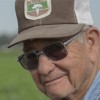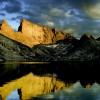 Water and humans: two powerful forces shaping our landscapes. Take a flight from Denver or Billings into some small western farming town to see the extent. From a few thousand feet up, one creek tendril builds around it a whole draw, and the draw makes up just one fringe in a frost-crystal fractal pattern of hills for miles across, say, the west edge of the Powder River Basin. From glaciated mountains to the driest desert basins, water leaves its mark in canyon scribbles, river bottom brush strokes, and pencil-line gullies.
Water and humans: two powerful forces shaping our landscapes. Take a flight from Denver or Billings into some small western farming town to see the extent. From a few thousand feet up, one creek tendril builds around it a whole draw, and the draw makes up just one fringe in a frost-crystal fractal pattern of hills for miles across, say, the west edge of the Powder River Basin. From glaciated mountains to the driest desert basins, water leaves its mark in canyon scribbles, river bottom brush strokes, and pencil-line gullies.
And the airborne passenger can’t miss the tidy grids of highways and gravel roads, the reservoir dams, or the straight-sided crop fields stippled over the land. From above, the marks of water and humans are sometimes indistinguishable, and always knitted together. Perhaps the most emblematic sign of the intersection between people and water is the perfect circles of center pivots. A delicately woven tapestry or a message spelled out in code?
Painter Virginia Moore’s landscapes bring these aerial views to ground level. Her pieces reconfigure our planet’s shapes and colors into bright abstractions. They also reveal our landscapes as they really are, not sentimentalized or pristine, but shaped by eons of water following gravity as well as decades of planning, labor, and construction. These images remind us of our power to alter the places we dwell, and of the smallness and fragility of our presence on this vast and ever-changing planet.
Starting with Virginia’s view from above, this issue of Western Confluence examines a few of our many relationships to water. The articles look at how we use, rely on, and manipulate water, from the simplest dirt irrigation ditches to elaborate tunneling-pumping-piping-trading-filtering-recycling systems. And they question how sustainable our use of water is. You’ll read about western cities trying to hold onto and make the most of a finite and infinitely valuable resource, as well as people who want to bring once-wild rivers back to life. It’s impossible for one issue of a magazine to give comprehensive treatment to everything water means to us. Instead, I hope this collection of stories will provide a thought-provoking glimpse at how water shapes our landscapes and lives in order to trigger ongoing conversation.
And as you read through, flip back to the cover image from time to time. Virginia is a young artist who lives in Lander, Wyoming. Her fresh and honest interpretation of the place we all call home puts these stories into the right perspective. Water is everywhere, essential, and evasive.
By Emilene Ostlind


